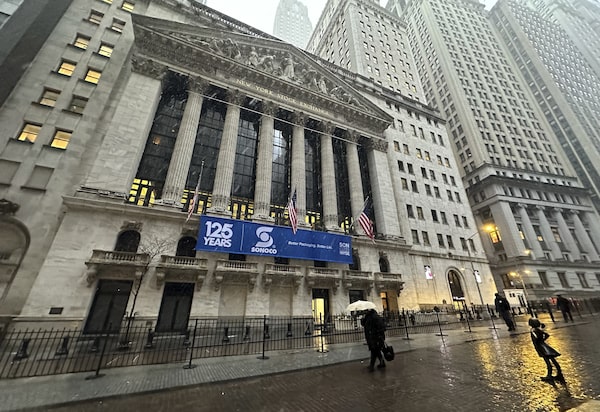
Pedestrians pass the New York Stock Exchange as snow falls in New York, on Feb. 13.Peter Morgan/The Associated Press
Stock markets in the United States are thriving again this year, outshining indexes almost everywhere else around the world, yet there is a peculiar trend playing out for individual U.S.-listed companies: Their shares can plummet at the first sign of bad news.
Sometimes it happens over something as simple as a softer outlook.
In the past week, shares of travel company Expedia Group Inc. EXPE-Q dropped 18 per cent in a single day after it reported earnings and commented on softer travel demand; shares of Snap Inc. SNAP-N, the parent company of social-media app Snapchat, plunged 35 per cent in one day because of disappointing revenue; and shares of payments company PayPal Holdings Inc. PYPL-Q slumped 11 per cent after it issued subdued earnings expectations.
The trend continued Tuesday when Canada’s own Shopify Inc. SHOP-T, which is dual-listed on the Toronto and New York stock exchanges, dropped 13 per cent on a weaker outlook, despite beating revenue expectations.
For weeks, analysts and portfolio managers have predicted that stocks were getting so frothy that there was no room for error, particularly in the technology sector. “Optimistic growth expectations, pricey valuations, and companies failing to deliver can easily create large reversals,” analysts at Bank of Nova Scotia warned clients earlier this month.
That fear is now being realized. Yet the prevalence of such sharp market swings also suggests something more structural is at play – because it isn’t just that stocks will plummet on bad news. They can also jump on a single earnings report. Meta Platforms Inc. META-Q, for instance, recently climbed 20 per cent in a single day.
“Anybody that has been around in the market for a long time is raising their eyebrows,” said Katherine Owen, a portfolio manager for global equities at Mackenzie Investments. “These swings don’t match up with the underlying change in fundamentals.”
Money managers are still trying to figure out the driving forces, but some, such as Ms. Owen, believe the rise in options trading by retail investors – particularly the explosive growth of zero-day options that expire after one trading session – is putting more emphasis on individual events, such as earnings reports.
The managers also think the growing number of quantitative funds that use trading algorithms can exacerbate market moves in either direction. Computer scripts often trade on momentum, so if a stock drops a few percentage points, it can trigger more selling by algorithms that track the downward movement.
And because passive investing through exchange-traded funds has become so popular, there aren’t as many active managers who can step in and turn the tide if they think a stock has turned cheap.
Each of these forces has been around for a few years now, and major market swings were a regular feature of the tech sector sell-off in 2022. Netflix Inc. NFLX-Q famously dropped 35.1 per cent in a single day after reporting that it lost subscribers in a quarter for the first time in more than a decade.
Yet almost two years have passed since, and during that time, the market has gone through a full-blown correction that was supposed to rid it of any COVID-19 pandemic froth.
There is also a growing acceptance lately that the U.S. market may not be all that overvalued, even though China, the world’s second-largest economy, is struggling and the geopolitical crisis in the Middle East is getting worse.
“Tech gains and cost-cutting have buoyed margins, but we see pressures mounting over time. We’re overall overweight U.S. stocks as we think rosy market sentiment can persist for now,” market strategists at BlackRock Inc.’s Investment Institute wrote in a note to clients last week.
That may be true for the broad market, but individual companies now face much more scrutiny, and that’s made it harder to bet against consensus. “It takes more psychological conviction than ever to be a contrarian investor,” said Jeff Mo, a portfolio manager at Mawer Investment Management who specializes in mid-cap U.S. stocks.
For those investors who are uncomfortable with taking that much risk, Mackenzie’s Ms. Owen stresses the age-old strategy: “The best thing to do is to hedge and diversify.”
“That’s actually how we position the portfolio,” she says of the fund she co-manages. “We just want a portfolio that’s resilient.”
 Tim Kiladze
Tim Kiladze